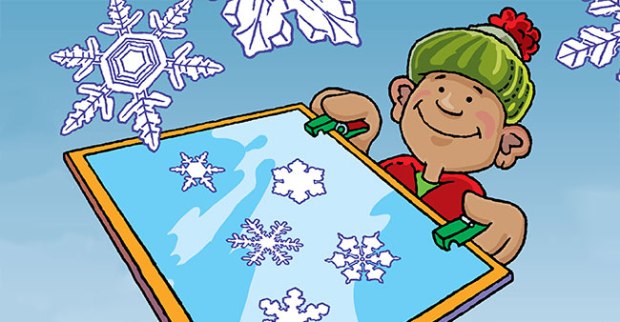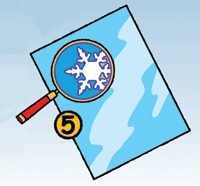Catch a Snowflake and Keep It Forever
Snowflakes are among nature’s most beautiful and short-lived creations. Yet there is a way to preserve these fragile wonders to study or admire them anytime you wish. You and a group of your friends can do this project with about $20 worth of supplies available at any art store. (And you’ll need a snowstorm.)

What You’ll Need:
- Two sheets of clear acetate (available in single sheets or in packages) for each person
- “Crystal Clear” acrylic coating (a spray-on plastic artists use to protect illustrations)
- Pieces of cardboard large enough to cover each acetate sheet
- Two clothespins per person
- Enough cardboard boxes or empty coolers to cover all the cardboard sheets
What You’ll Do:
 Step 1: Stash the acetate and cardboard sheets in the freezer. Turn the box or cooler upside down outdoors. Place can of acrylic outside to cool.
Step 1: Stash the acetate and cardboard sheets in the freezer. Turn the box or cooler upside down outdoors. Place can of acrylic outside to cool.
 Step 2: Once it starts to snow, take the acetate and cardboard from the freezer and head outside. Duck under a porch or overhang to protect everything from falling snow. With clothespins, fasten a single sheet of acetate to a piece of cardboard. Spray the acetate sheet with a thin coat of acrylic from the air-chilled can. (If you use too much, the snow will melt in the liquid.)
Step 2: Once it starts to snow, take the acetate and cardboard from the freezer and head outside. Duck under a porch or overhang to protect everything from falling snow. With clothespins, fasten a single sheet of acetate to a piece of cardboard. Spray the acetate sheet with a thin coat of acrylic from the air-chilled can. (If you use too much, the snow will melt in the liquid.)
 Step 3: Hold up the contraption by the clothespins and step out in the falling snow so that individual flakes collect on the acetate sheet. You’ll want a lot, but not so many that they begin to fall on top of one another.
Step 3: Hold up the contraption by the clothespins and step out in the falling snow so that individual flakes collect on the acetate sheet. You’ll want a lot, but not so many that they begin to fall on top of one another.
 Step 4: Once you have enough, carefully tuck the sheet under the cardboard box or cooler.
Step 4: Once you have enough, carefully tuck the sheet under the cardboard box or cooler.
 Step 5: After an hour, the snowflakes that stuck to the acetate will have evaporated, leaving behind perfect acrylic replicas. Hold the acetate up to a light and scan the sheet with a magnifying glass or an 8X slide viewer. You may also project the crystalline images onto a screen with an overhead projector.
Step 5: After an hour, the snowflakes that stuck to the acetate will have evaporated, leaving behind perfect acrylic replicas. Hold the acetate up to a light and scan the sheet with a magnifying glass or an 8X slide viewer. You may also project the crystalline images onto a screen with an overhead projector.
FROZEN FACTS
- Snowflakes form when water vapor freezes around tiny bits of dust in the air. No dust, no snowflakes.
- Scientists have identified 10 types, including graupel (granular) flakes, as well as sleet and hail. The other seven varieties are the more familiar crystal shapes.
- No two snowflakes are alike? In the mid-1980’s, a scientist found snowflakes that were extremely similar 20,000 feet in the air above Wisconsin.
- Snow crystals are always six-sided, because the atoms in water molecules are arranged in triangles.
- The exact size and shape of a snowflake depend on the temperature, moisture content in the air and how much time it has to grow before hitting the ground—or your acetate sheet.
this is awesome. I can’t wait till next year when it snows to try this
i am going to share this with my art teacher!!
this is so awesome !!! +_+
cool its awesome
jamestown
woah! this is the craziest thing…I did this a topic to my reasearch paper for my life goal and now i know it is possible i am going to try it!
this was one of my things that i had on my life list! and now it is possible!
wow I might try that. awsome
introesting
awsome
if only it snowed in arizona :/ 🙁
oooh… aaah…